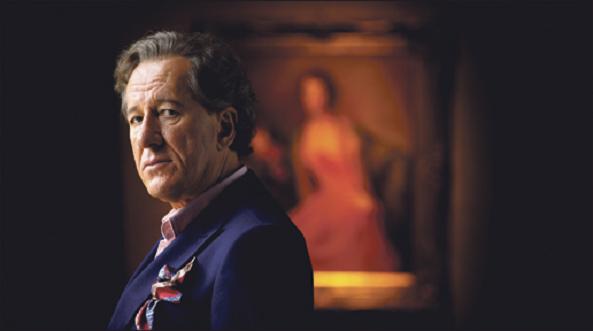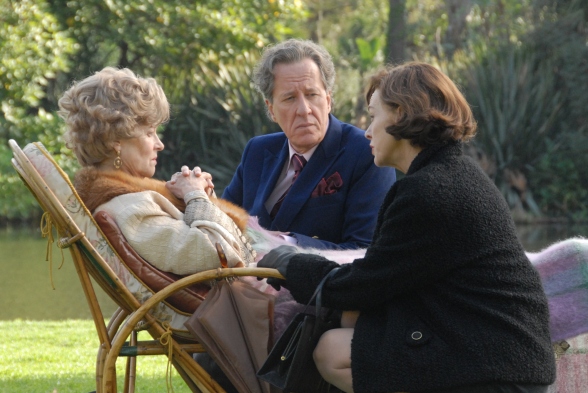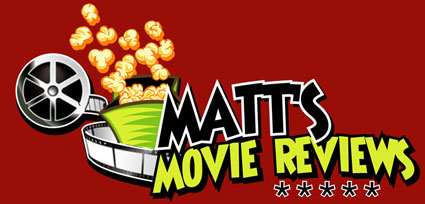Compile a list of Australia’s greatest actors and Geoffrey Rush is sure to be a contender for the top spot.
Joining the Queensland Theatre Company in 1971, Rush appeared in renditions of “King Lear” and “Aladdin”. 25 years later, he was catapulted into movie stardom after winning every award imaginable -including the Oscar- for his portrayal of schizoaffective pianist David Helfgott in Shine.
Since then Rush has been a fixture on stage as well as screen, winning acclaim for roles in films varied as Quills, Pirates of the Caribbean, and The King’s Speech.
Rush returns once again to local shores in The Eye of the Storm, a biting drama co-starring Judy Davis and Charlotte Rampling, and directed by Australian filmmaking legend Fred Schepisi in his first local feature in over two decades.
Matt’s Movie Reviews spoke to Rush about making The Eye of the Storm and his career thus far.
Enjoy!
Did you know of Patrick White’s novel before receiving the script?
I haven’t read the novel, but I knew Patrick as a playwright, primarily. I’ve been involved with his later work when he was sort of rediscovered, I suppose, by Neil Armfield the director, a long time collaborator of mine.
Jim Sharman, I think done revivals of the work in the late ‘70s “The Season of Sarsaparilla” and “The Cheery Soul”. Jim then commissioned Patrick to write a play for Lighthouse Theatre Company, which is the state theatre company in South Australia, back in the early ‘80s. I was a member of that ensemble.
Subsequently, Neil went off and directed revivals of “The Ham Funeral”, “The Season of Sarsaparilla”, “The Cheery Soul”, and “Night on Bald Mountain”, during a time at Lighthouse where Patrick wrote another play called “Netherwood”, and in the late ‘80s in Adelaide we all put together a production of a play of his called “Shepherd on the Rocks”.
So I knew Patrick when he was probably in his late 60s, early 70s. The only other novel I had been aware of was “Voss” which I read, and which was turned into an opera as well. I also read “The Solid Mandala”, but I never read The Eye of the Storm.
I know it intimately now! (laughs) Fred Schepisi was very keen in the pre-production period, particularly with Judy Davis and myself, we spent quite a number of weeks in a sort of developmental workshop phase, where he said “I want you to dig into the novel and see if there are any elements that you think will help the life and characterisations that Judy Morris outlined in her screenplay”.
Have you always wanted to work with Fred Schepisi?
Yeah. I got to know Fred quite well over the last 10 years. I am a patron for the Melbourne Film Festival, and Fred seems to spend half his time in New York and half his time in Australia, and we’re neighbours in the country, down in the Mornington Peninsula. We see each other quite a lot, socially.
A couple of years back at the Melbourne Film Festival, they asked me to host a retrospective screening of a favourite Australian film, and I chose The Chant of Jimmy Blacksmith. I remember seeing it back in the late ‘70s when it was released. I had just come back from having lived in Europe for about 4 years, and was aware that there was a major new development in Australian filmmaking, and ...Jimmy Blacksmith I think is an absolute classic.
At the screening it was very interesting, because I was interested in how many people would turn up for it. But the cinema was packed. There were 400-500 people, and the great thing is a lot of them were probably in their 20s and 30s, and you could feel from the auditorium that for them it was an old movie, something way before their time and you could sense that people were in the presence of extraordinarily great filmmaking that hasn’t dated. Like a good wine it has matured.
It is a pretty tough story about a white society’s conflict with an indigenous population. A very specific story. But I’ve always felt that if you look at Fred’s body of work, to me he is one of those great directors who finds what’s inside the story and brings it to life with the greatest dramatic detail that he can give it, without ever putting an overtly personal stamp on it, you know what I mean?
There are no kind of overt hallmarks. If you look at any of his early Australian films like The Devil’s Playground and ...Jimmy Blacksmith, through to the work of the Hollywood studio system like Russia House and Six Degrees of Separation, there is no common theme. They are very diverse projects, but they kind of live and breathe on their own terms.
 |
"With something like Pirates..., you are working on a huge monetary scale. But ultimately once you get into a duologue between you and another actor, the same principals of approaching a characterisation or the nature of a performance come from generally the same rule book. " - Geoffrey Rush |
Working alongside such formidable talents like Judy Davis and Charlottle Rampling, does that force you to lift up your game?
Of course. I’ve worked with Judy on four films. The first one was Hoodwinked (laughs), which was made in 1980. We didn’t actually work together on that. We were both in the credits list. She was really the star of it and I had a very small part.
But subsequently we shot from the mid ‘90s onwards Children of the Revolution, and then Swimming Upstream. So I probably appeared more with her in Australian films than anybody else.
Your character Basil Hunter is strange, in that he puts on an act whenever he is off the stage, yet on the stage he wants to reveal everything about himself. Is that typical of actors as a whole?
It’s a very interesting point. In the story from the novel, both Basil and Dorothy well into their middle age with an aging mother, and both siblings have reached some kind of dead end in their lives.
Dorothy married into European royalty, and that’s been a complete failure and shattered her sense of self. While Basil has become a very famous Australian ex-patriot, knighted actor in the London theatre world, but he’s also reached some sort of sense of personal malaise, and the story brings them both back to Australia because there dying mother is there. But it’s quiet mercenary, they just need the cash (laughs).
Is there a difference in the way you approach a big budget movie like Pirates of the Caribbean to the way you would a local production like The Eye of the Storm?
No. It’s interesting...a couple of months ago we just did a global junket for Pirates..., and that question got asked a lot. I remember Johnny Depp saying that the process is no different, but it’s probably a little different with something like Pirate...s because it’s not a four chapter saga. So there is more familiarity in terms of the direction of the characters, where you don’t have to invent unseen activities for that character because you probably played them at some point in another film. The personal character references are sort of part and parcel of what you are doing.
The difference is more in terms of tone. With something like Pirates..., you are working on a huge monetary scale. It’s a fiercely commercial form, so it’s a much bigger event in terms of the number of personnel, stunt teams, marine teams, visual effects people, etc.
But ultimately once you get into a duologue between you and another actor, whether it’s Barbossa and Jack Sparrow, or whether it’s Basil Hunter and Dorothy, once you and a number of actors are in front of the camera, the same principals of approaching a characterisation or the nature of a performance come from generally the same rule book.
If you wanted to make comparisons in The Eye of the Storm there are many more intense, and probably subtler or intimate scenes between the minds of the characters. We don’t break into sword fights in Eye of the Storm (laughs), or go into big extravagant set pieces. But then again there is a massive cyclone which sweeps through the centre of the story, that on a lesser but probably more imaginative level, which is a challenge for the effects people.
When something like The King’s Speech comes along, did you have any inkling of the kind of success it would generate?
No, not really. We always thought on that film, or I always thought that it was the most intriguing, elemental story between two high unlikely antagonists...two characters who find themselves operating inside the same world. One from this dynastic royal family heritage, and the other one a nobody from the other side of the world.
I found the divide between them, the imperial and the colonial, would be hopefully a fascinating story. But it was a relatively low budget film, I think it was $14 million dollars and made $400 million, so it was half of what Pirates... made (laughs). But no, it went way beyond expectations. In the back of my mind I thought, “This is ultimately about two middle aged men involved in a ridiculous scenario, most of which is talking in a room. Is that going to be electrifying or engaging for an audience?” As it turned out it was.
So I have high hopes for two middle aged children fighting over their mother’s inheritance, may just spark something! (laughs) I know the number of people who have seen the film at various press screenings or industry screenings, they all come out and say “Wow! Families.” (laughs)
 |
"I have high hopes that two middle aged children fighting over their mother’s inheritance may just spark something!" - Geoffrey Rush |
You are so prolific. There must be 6 0r 7 films in your filmography over the last year alone. What do you like to do in your down time?
Well, I’m in that period now. The last couple of years have been involved, doing quite a substantial balance between theatre, we did a play “The Diary of a Madman” at Belvoir St late last year and then took it to New York earlier this year. Then there was “The Drowsy Chaperone” the musical last year, and then sandwiched in Pirates... and Eye of the Storm around all of that.
So I’m taking a good long break now to reconnect with family life. I’m not doing anything until the end of the year, when I put of the bustle and tape up the tackle to play Lady Bracknell! (laughs)
What hobbies do you like to do during your downtime?
For me it’s really just getting on with life, you know? Getting back into being part of the day to day running of the family, the cooking, getting to read, getting to watch TV with my kids or listen to music, catch up on stuff...maybe think about tinkering with a writer idea, I don’t know.
I always thought if you take a sort of enforced sabbatical it can let your mind go black for a while, and see what pops in.
Your career began in the theatre with The Queensland Theatre Company, and you still like to tread the boards. What brings you more pleasure: film or stage?
Well, I sort of not abandoned, but got sidetracked by going into films about 15 years ago, and did proportionately much less theatre than I had in the first 25 years, where I was doing 8 shows a year, or something.
But in the last couple of years I found this balance between, and maybe I was lucky, but they were very interesting projects. Once I did “Exit the King” on Broadway 4 years ago, I was very keen to kind at kick at that door again sooner rather than later, so it was fantastic to go over to the Brooklyn Academy earlier this year.
So yeah, a bit of both is enlightening.
|
